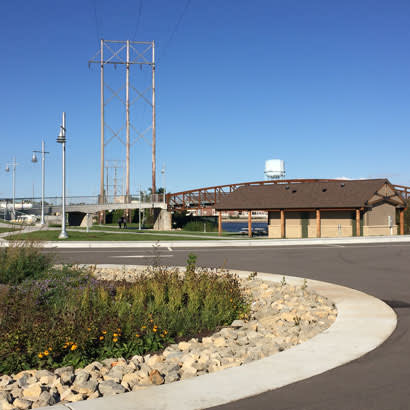
As cities in Wisconsin and across the United States transition away from an industrial past, land use issues become increasingly difficult. This is especially true with contaminated sites that are usually inappropriate for other uses and pose a barrier to redevelopment. Such was the case in Oshkosh, Wisconsin, where riverfront property originally designed with barge traffic and chemical usage in mind, was deemed unsuitable for use in today’s economy and a severe detriment to a major natural resource.
The global infrastructure firm, AECOM, worked with the city of Oshkosh, as well as environmental and public stakeholders to transform the formerly dilapidated marina into public space for recreational uses. Called the Oshkosh Boatworks Riverwalk/Park Development, this redesigned public asset along the Fox River features a new 575-foot-long pedestrian bridge and an ADA-accessible kayak/canoe launch, along with a shelter/restroom, parking lot and stormwater controls.
Environmentally Difficult Site
In 2004, the Environmental Protection Agency (EPA) designated the site, a former lumber yard and boat manufacturing location for more than 100 years, as a brownfield. Because of impacts from abandoned buildings and petroleum products, solvents, metals and PCBs in the soil, groundwater and sediments, the entire waterfront area was deemed off limits to the public and considered a nuisance to the surrounding neighborhood. The property is in an area designated by the Department of Housing and Urban Development (HUD) as a low-to-moderate income (LMI) census tract.
Redevelopment of the property has begun to play an important part in reversing the HUD designation and restoring the riverfront for all citizens of Oshkosh. The old industrial facilities are being transformed into commercial, residential and retail developments along the riverfront. The Boatworks property and the Riverwalk trail system are spurring this development by helping to revitalize the historic downtown and riverfront areas, adding value and demand to the area while attracting citizens and tourists.
Resolving Design Challenges
The engineering team resolved several design challenges while constructing around the old man-made landfill. Foundations for the bridge and its supporting structures needed to accommodate the impacted soils. Since the bridge itself is pile-supported, preloading and selective undercutting were used to construct the approach embankments to reduce the construction cost and minimize the amount of impacted soils that would need to be landfilled.
A prefabricated, two-span bridge, constructed from weathering steel, was chosen to reduce the construction time and cut costs for the pedestrian bridge. The weathering steel not only matches the aesthetics of a recently constructed Canadian National Railroad (CNR) movable bridge downstream from the Boatworks redevelopment, but also reduces the city’s long-term maintenance requirements. For the occupied restroom building, an under-slab passive ventilation system was used to mitigate the potential for methane intrusion into the building, creating a safer environment for occupants.
Multiple Recreational Facilities
The Boatworks project encompasses both onshore and waterfront developments. Onshore development consists primarily of the riverwalk trail system, a picnic area, public restrooms and parking. Waterfront development includes boating facilities, such as the ADA-compliant kayak/canoe launch area, and site improvements, such as seawalls, rip-rap and natural shoreline revegetation. The Boatworks facility also connects to an adjacent fishing pier, which was built on an old railway crossing.
The Riverwalk trail system is a looped, multiuse pathway and riverwalk system that includes both sides of the Fox River, between the Wisconsin Street Bridge and the Main Street Bridge, and connects with the Leach Amphitheater complex. The riverwalk provides continuous access along the downtown reach of the Fox River, as well as linkages to adjacent neighborhoods and the WIOUWASH state trail, a multi-county recreational trail that extends through Winnebago, Outagamie, Waupaca and Shawano — from Hortonville to its termination at the newly constructed Wisconsin Street Bridge in Oshkosh.
The upland development feature of this section of the Riverwalk consists of a 12-foot-wide concrete path with benches and lighting. Landscaping occurs between the trail and river, with a 5-foot zone between the south edge of the concrete walkway and the north limit of the private parcels. Landscaping materials consist of low-stature native perennials and native canopy trees. The concrete Riverwalk curves up to a 12-foot-wide dual-metal trussell bridge that spans an island located in the middle of the lagoon, with a wildlife viewing platform located in the middle of the bridge. Additional upland features include a parking lot area with ADA-compliant bathroom facilities and a picnic shelter.
Engaging Local Stakeholders
The city of Oshkosh has been planning the Fox River Riverwalk and Boatworks redevelopment area for more than 15 years. Public input, a critical component of the planning process, was initiated in several ways: public meetings with the Common Council and Redevelopment Authority, an online survey on the city’s website and a group survey targeted at specific user groups. Public input was also provided at a May 26, 2011, Advisory Parks Board meeting, and finally, meetings with city representatives and the park staff provided critical input on existing and potential park needs.
On September 29, 2016, the parks department hosted a grand opening for the Boatworks redevelopment site. Music, food, speeches from public figures and a demonstration of the ADA-compliant kayak launch were enjoyed by the public.
According to Ray Maurer, parks director in Oshkosh: “The entire Riverwalk project has significantly rejuvenated the downtown and river access. The Boatworks site has really become a focal point of the Riverwalk system thanks to the addition of the pedestrian bridge and the accessible kayak/canoe launch. Incorporating the original bridge portals from the CNR bridge built in 1899 into the Riverwalk system pays tribute to the historic significance of the sites along the Fox River.”
Andrew Mott is a Senior Project Manager at AECOM.

